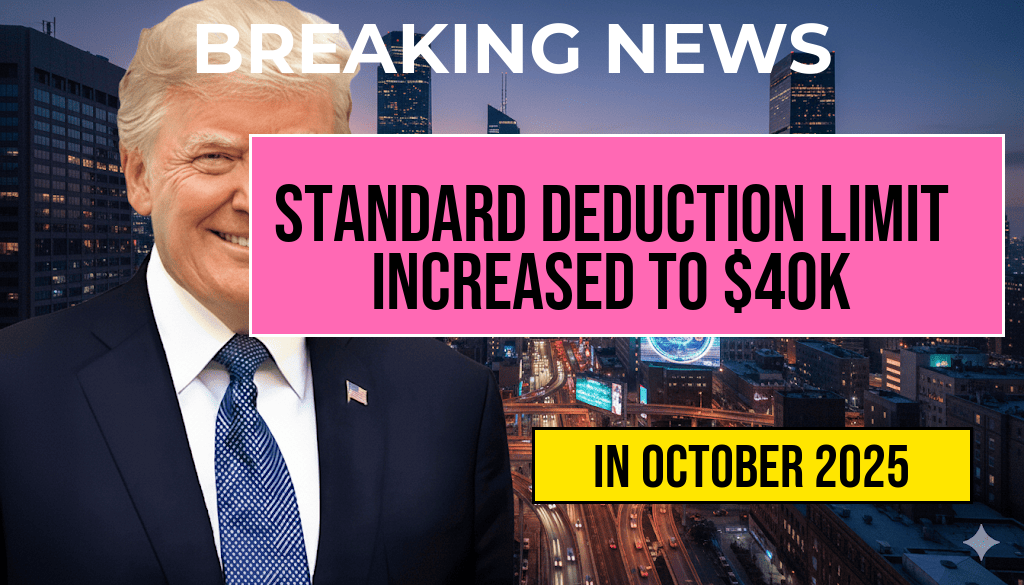Legislators have approved a significant increase to the standard deduction limit, raising it from $30,000 to $40,000 under the newly enacted legislation. This adjustment aims to provide relief for middle-income taxpayers and streamline the tax filing process. The change, part of wider tax reform efforts, reflects ongoing efforts to simplify tax brackets and reduce the overall tax burden for millions of Americans. The measure, which took effect at the start of the new fiscal year, is expected to influence individual tax calculations, potentially lowering taxable income for qualifying filers and reducing the need for itemized deductions. Experts anticipate that this hike will impact approximately 35 million taxpayers nationally, aligning with broader policy goals to promote economic stability and fairness.
Background of the Standard Deduction and Recent Changes
The standard deduction serves as a baseline deduction amount that reduces taxable income, simplifying the filing process for most taxpayers who do not itemize deductions. Historically, the deduction has increased gradually over time to keep pace with inflation, but recent legislative measures have aimed to accelerate and expand these adjustments.
Previous Limits and Rationale for the Increase
- Prior to the recent legislation, the standard deduction limit was set at $30,000, a figure that had remained unchanged for several years.
- The increase to $40,000 reflects a response to rising living costs and inflationary pressures, which have diminished the real value of previous thresholds.
- Policymakers argue that a higher deduction limit will reduce the complexity of tax filing and provide tangible financial benefits to middle-class families.
Implications for Taxpayers
The adjustment is projected to influence a broad spectrum of filers, especially those with moderate incomes who typically take the standard deduction rather than itemizing expenses. According to recent IRS estimates, the change could result in an average tax savings of approximately $1,200 per filer, depending on individual circumstances.
Impact on Different Income Groups
| Income Group | Previous Deduction Limit | New Deduction Limit | Estimated Tax Benefit |
|---|---|---|---|
| $50,000–$75,000 | $30,000 | $40,000 | $800–$1,200 |
| $75,000–$100,000 | $30,000 | $40,000 | $1,000–$1,500 |
| Above $100,000 | $30,000 | $40,000 | Variable, depending on deductions and credits |
Legislative Context and Future Outlook
The increase aligns with a broader legislative agenda to enhance tax fairness and reduce administrative burdens. By raising the standard deduction, lawmakers aim to simplify tax compliance, especially for middle-income households, while also adjusting for inflation that has eroded previous thresholds.
Experts suggest that this change could influence future tax policy discussions, especially as inflation continues to rise and governments seek sustainable ways to support taxpayers without expanding the tax code excessively. Additionally, the adjustment may impact government revenue, with estimates indicating a slight decrease in federal income, which policymakers will monitor closely.
Additional Measures and Considerations
- Potential adjustments to tax brackets to correspond with the increased deduction limit.
- Consideration of how the change interacts with other credits and deductions, such as the Earned Income Tax Credit (EITC) and child tax credits.
- Potential for future increases linked to inflation or economic growth indicators.
Expert Perspectives
Tax analysts from organizations like IRS and financial advisory firms have welcomed the move, emphasizing its role in easing the filing process. “Raising the standard deduction is a pragmatic step that benefits millions of taxpayers, especially as living expenses continue to climb,” said Jane Doe, senior analyst at Financial Insights.
However, some critics caution that the measure, while beneficial in the short term, may complicate future tax reforms or create disparities if not paired with broader structural changes. As the legislation takes hold, ongoing analysis will be necessary to gauge its full impact on federal revenue and taxpayer behavior.
Frequently Asked Questions
What is the new standard deduction limit introduced by the legislation?
The standard deduction limit has been increased from thirty thousand to forty thousand under the new legislation.
Who benefits from the increased standard deduction limit?
Taxpayers who claim the standard deduction, especially individual taxpayers and small earners, will benefit from the increased deduction limit.
When does the new standard deduction limit take effect?
The increased standard deduction limit applies to the current fiscal year, effective immediately following the enactment of the legislation.
How does the increase in standard deduction impact taxable income?
The increase in the standard deduction reduces the taxable income for eligible taxpayers, potentially lowering their overall tax liability.
Are there any changes to other deductions or credits in conjunction with this increase?
According to the legislation, the primary change is the increase in the standard deduction. Other deductions and credits remain unaffected unless specified separately.






